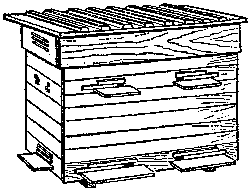The main hive body is simplicity to build. The only hard bit, as long as cuts are accurate, is the rebate on the side rails. There is not one nail in those I made; good long screws, properly piloted, for joining the 18mm ply and the substantial cross braces. I did consider extending the long sides slightly and cutting slots in the shorter sides, but settled for butt joints as per the destructions.
The roofs are simply built up as required, dependent on type chosen - I made mine in the gabled style, but the pent version would have been easier, and cheaper too.
The 'country' style legs are more of a pain than the simple vertical option, but once the jig had been made for the planer, making interchangeable legs was a doddle. For mine, the legs fold out horizontally, making it easy for two people to carry a hive, even with bees at home.
The floor benefits from being in one sheet - my first had two halves, and I have regretted that economy - and the expanded metal flooring, while possibly heavier lends even more rigidity to the box than a woven mesh. It is also easier blanking one end from the other, as well.
Supers? I nearly always use National shallows, sometimes using the half supers only as props for the roof.
Carry boxes? Just not needed for most. I have used mine once only, and that was for a demonstration; they have since been used as nucs and bait hives with proper roofs and fitted with floors as necessary. Certainly would not need six of them!
So, with some thought, they can be knocked up to Robin's destructions, or a very close copy with a few modifications, for relatively little money. A sheet of 18mm ply would make a hive with about 20% spare, if forgetting the half supers and carry boxes, so 2 sheets might make three bodies with cover boards. A sheet of 9mm would be sufficient for the three roofs with about a third left over. Softwood battens are standard sections, so easily sourced; the odds and ends would be cut from the leftovers and one can make some half supers if really needed from leftovers and perhaps some extra material.
I believe the destructions for making these are still available from Robin, but if not I could help with some dimensions, but would not wish to copy his booklet as it is his material. Basic dimensions are really easy to sort out - National frames have to be accommodated, after all, so dimensions are fixed to the National internal measurements, but just a tad longer..... or even a lot longer.....





